Top Rankings
Newcastle School District ranks among the top 20% of public school district in Oklahoma for:
Category
Attribute
Graduation Rate
Highest graduation rate (Top 10%)
Community Size
Largest student body (number of students) (Top 1%)
For the 2025 school year, there are 4 public schools serving 2,643 students in Newcastle School District. This district's average testing ranking is 7/10, which is in the top 50% of public schools in Oklahoma.
Public Schools in Newcastle School District have an average math proficiency score of 29% (versus the Oklahoma public school average of 25%), and reading proficiency score of 30% (versus the 27% statewide average).
Minority enrollment is 37% of the student body (majority Hispanic), which is less than the Oklahoma public school average of 56% (majority Hispanic and American Indian).
Overview
This School District
This State (OK)
# Schools
4 Schools
1,794 Schools
# Students
2,643 Students
721,016 Students
# Teachers
153 Teachers
43,565 Teachers
Student : Teacher Ratio
17:1
17:1
District Rank
Newcastle School District, which is ranked within the top 50% of all 533 school districts in Oklahoma (based off of combined math and reading proficiency testing data) for the 2021-2022 school year.
The school district's graduation rate of 90-94% has stayed relatively flat over five school years.
Overall District Rank
#165 out of 538 school districts
(Top 50%)
(Top 50%)

Math Test Scores (% Proficient)
29%
25%
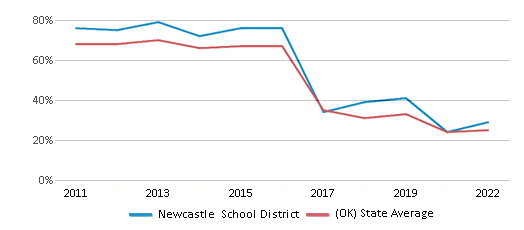
Reading/Language Arts Test Scores (% Proficient)
30%
27%

Science Test Scores (% Proficient)
37%
31%
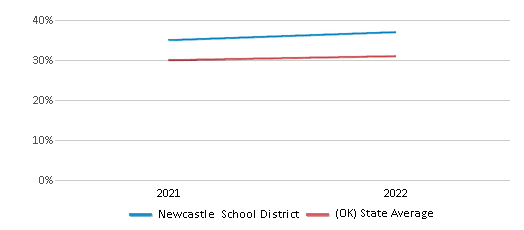
Graduation Rate
(20-21)90-94%
78%
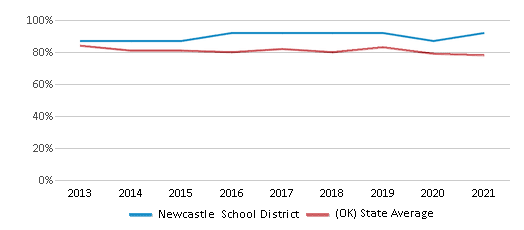
Students by Ethnicity:
Diversity Score
0.57
0.73
# American Indian Students
219 Students
78,002 Students
% American Indian Students
8%
11%
# Asian Students
18 Students
16,351 Students
% Asian Students
1%
2%
# Hispanic Students
329 Students
146,732 Students
% Hispanic Students
12%
20%
# Black Students
52 Students
57,572 Students
% Black Students
2%
8%
# White Students
1,652 Students
320,142 Students
% White Students
63%
44%
# Hawaiian Students
2 Students
3,156 Students
% Hawaiian Students
n/a
1%
# Two or more races Students
371 Students
98,894 Students
% of Two or more races Students
14%
14%
Students by Grade:
# Students in PK Grade:
147
38,038
# Students in K Grade:
164
49,325
# Students in 1st Grade:
166
51,638
# Students in 2nd Grade:
172
51,822
# Students in 3rd Grade:
192
51,866
# Students in 4th Grade:
191
51,270
# Students in 5th Grade:
198
51,780
# Students in 6th Grade:
201
52,317
# Students in 7th Grade:
199
53,730
# Students in 8th Grade:
218
55,226
# Students in 9th Grade:
198
57,588
# Students in 10th Grade:
211
55,440
# Students in 11th Grade:
203
52,900
# Students in 12th Grade:
183
48,076
# Ungraded Students:
-
-
District Revenue and Spending
The revenue/student of $9,385 in this school district is less than the state median of $10,983. The school district revenue/student has declined by 13% over four school years.
The school district's spending/student of $9,444 is less than the state median of $10,957. The school district spending/student has declined by 13% over four school years.
Total Revenue
$25 MM
$7,919 MM

Spending
$25 MM
$7,900 MM

Revenue / Student
$9,385
$10,983
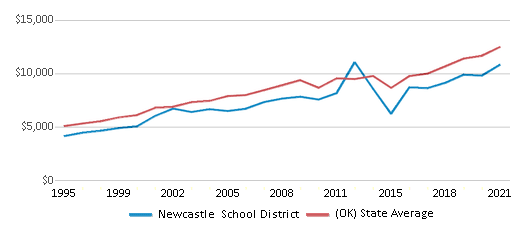
Spending / Student
$9,444
$10,957
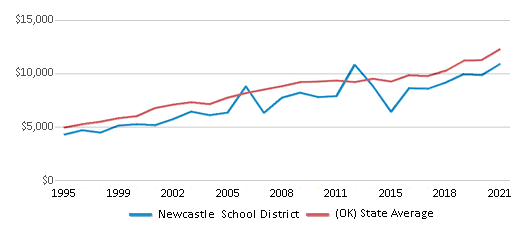
Best Newcastle School District Public Schools (2025)
School
(Math and Reading Proficiency)
(Math and Reading Proficiency)
Location
Grades
Students
Rank: #11.
Newcastle Elementary School
(Math: 40% | Reading: 30%)
Rank:
Rank:
8/
Top 30%10
418 Northwest 10th Street
Newcastle, OK 73065
(405) 387-6474
Newcastle, OK 73065
(405) 387-6474
Grades: 2-5
| 753 students
Rank: #22.
Newcastle Middle School
(Math: 21% | Reading: 30%)
Rank:
Rank:
6/
Top 50%10
611 East Fox Lane
Newcastle, OK 73065
(405) 387-3139
Newcastle, OK 73065
(405) 387-3139
Grades: 6-8
| 618 students
Rank: #33.
Newcastle High School
(Math: 15-19% | Reading: 30-34%)
Rank:
Rank:
5/
Bottom 50%10
101 North Main Street
Newcastle, OK 73065
(405) 387-4304
Newcastle, OK 73065
(405) 387-4304
Grades: 9-12
| 795 students
Rank: n/an/a
251 N E 2nd Street
Newcastle, OK 73065
(405) 387-6200
Newcastle, OK 73065
(405) 387-6200
Grades: PK-1
| 477 students
Frequently Asked Questions
How many schools belong to Newcastle School District?
Newcastle School District manages 4 public schools serving 2,643 students.
What is the rank of Newcastle School District?
Newcastle School District is ranked #168 out of 533 school districts in Oklahoma (top 50%) based off of combined math and reading proficiency testing data for the 2021-2022 school year. This district ranks in the top 20% of Oklahoma school districts for: Highest graduation rate (Top 10%) and Largest student body (number of students) (Top 1%)
What is the racial composition of students in Newcastle School District?
63% of Newcastle School District students are White, 14% of students are Two or more races, 12% of students are Hispanic, 8% of students are American Indian, 2% of students are Black, and 1% of students are Asian.
What is the student/teacher ratio of Newcastle School District?
Newcastle School District has a student/teacher ratio of 17:1, which is equal to the Oklahoma state average of 17:1.
What is Newcastle School District's spending/student ratio?
The school district's spending/student of $9,444 is less than the state median of $10,957. The school district spending/student has declined by 13% over four school years.
Recent Articles

Year-Round Or Traditional Schedule?
Which is more appropriate for your child? A year-round attendance schedule or traditional schedule? We look at the pros and cons.

Why You Should Encourage Your Child to Join a Sports Team
Participating in team sports has a great many benefits for children, there is no doubt. In this article you will learn what those benefits are.

White Students are Now the Minority in U.S. Public Schools
Increasing birth rates among immigrant families from Asia and Central and South America, combined with lower birth rates among white families, means that for the first time in history, public school students in the United States are majority-minority. This shift in demographics poses difficulties for schools as they work to accommodate children of varying language abilities and socio-economic backgrounds.





